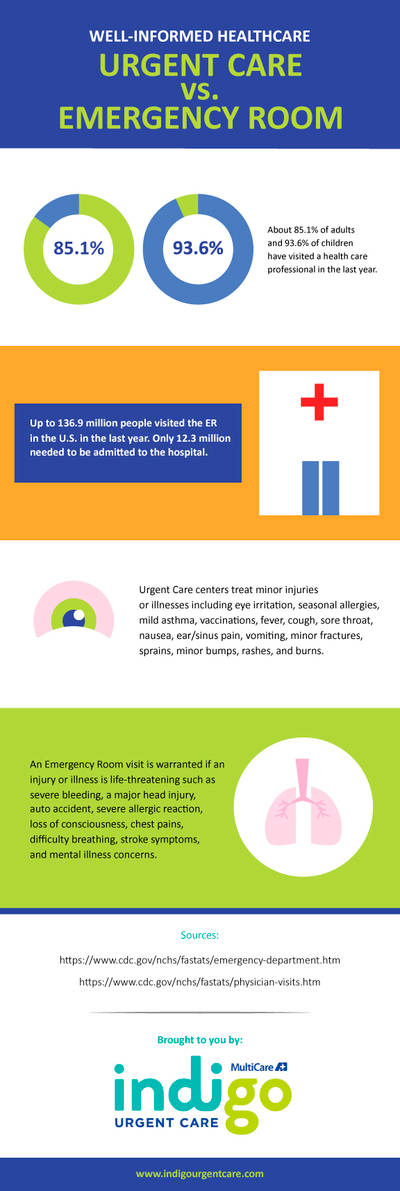In the past year, the Centers for Disease Control (CDC) estimates that 93.6% of children had contact with a health care professional. Most of these cases were for preventive care and regular checkups. But many visits were for illnesses or injuries – which are generally unexpected, out of our control and may occur after regular office hours.
Urgent care centers and emergency rooms are among the most commonly used places for treating injuries and illnesses. The trouble is, when your child is crying and you’re in a hurry to make a decision, it’s a difficult time to consider the difference between the two. While they share similarities, emergency rooms and urgent care centers are not the same. Let’s explore the differences.
Emergency Room: For serious, life-threatening problems
The emergency room (ER) is set up to treat serious injuries and life-threatening medical issues. From board-certified emergency room physicians and skilled nurses to sophisticated trauma rooms, labs and imaging equipment, the ER is a high-tech and high-performing marvel. But it isn’t the best place to handle every bump, bruise, cut, burn and cough that comes through its doors. And when less serious conditions land in the emergency room, the time you wait to receive care may be longer as more serious medical emergencies are treated first.
In the most recent version of the National Hospital Ambulatory Medical Care Survey, the CDC found that 136.9 million people visited emergency departments in the United States last year. Of those visits, only 12.3 million – or 9% – were admitted to the hospital. While many of these visits were necessary, most experts agree a large percentage of patients could be treated elsewhere. Yet because ERs are open around-the-clock, every day of the year, consumers still use them for any after-hours medical care.
What types of illnesses or injuries warrant a visit to the emergency room? An ER visit is recommended for any serious and life-threatening illnesses or injuries, including:
Head injuries and/or Auto accidents
Falls that may involve multiple injuries
Severe allergic reactions
Uncontrollable or severe bleeding
Loss of consciousness or vision
Chest pains and breathing difficulty
Stroke symptoms
Mental illness concerns
These medical issues can be life-threatening and should be treated as emergencies as quickly as possible.
Urgent Care Services: Your best option for minor illnesses and injuries
Urgent care clinics treat minor illnesses and injuries. But they’re not intended for serious injuries or illnesses, or any condition that may be life-threatening. This line can be blurry, so here are a few things urgent care centers commonly treat:
Minor fractures, sprains, strains
Minor bumps/scrapes/ cuts, rashes, burns, etc.
Fever, cough, sore throat, ear/sinus pain, general cold/flu symptoms
Nausea, vomiting, diarrhea
Seasonal allergies, eye irritation, mild asthma
Basic lab tests such as flu or strep tests
Because urgent care centers focus on non-life-threatening symptoms, they generally keep standard business hours. Indigo Urgent Care, for example, is open 8 am to 8 pm daily. Urgent care clinics accept walk-ins and most insurance policies, but shouldn’t be treated as an ER, 24-hour pharmacy or in-patient care unit.
Since most urgent cares have a website, it’s a good idea to check on hours, services and whether they accept your insurance, before you visit. Some urgent cares also offer a flat-fee for those who don’t have insurance.
Urgent cares also work hand-in-hand with area emergency rooms. If your condition is more serious or complex, you will be transferred to the closest emergency room.
Informed health care is better health care
When you or a loved one is sick or injured, it’s challenging to research options and know what’s best. That’s why we encourage you to check out where your local urgent care centers are located, what they treat (and what they don’t), hours and what insurance is accepted.
It’s also important to know where local emergency rooms are located. Be sure to review your insurance coverage for ER visits. Some insurance plans charge a premium for using the ER for minor illnesses such as the flu or an ear infection.
While none of us can prevent injury or illness, we can take preventive steps to know and understand what health care facilities are best suited for minor conditions – and when to seek emergency room treatment.
– Indigo Urgent Care
https://www.indigourgentcare.com/
* Remember, if you suspect you have symptoms of coronavirus/ COVID-19 (fever, cough, breathing issues), call your healthcare provider before going to the clinic or hospital. Calling first will help the clinic or hospital prepare to greet you and take care of you in the safest possible way. It may be recommended that you stay home and monitor your symptoms.
Seek prompt medical attention if your illness is worsening (for example, shortness of breath or difficulty breathing). Put on a facemask that covers your nose and mouth before you enter any facility or emergency vehicle. After you put on the facemask, clean your hands with soap and water or alcohol-based hand sanitizer.





